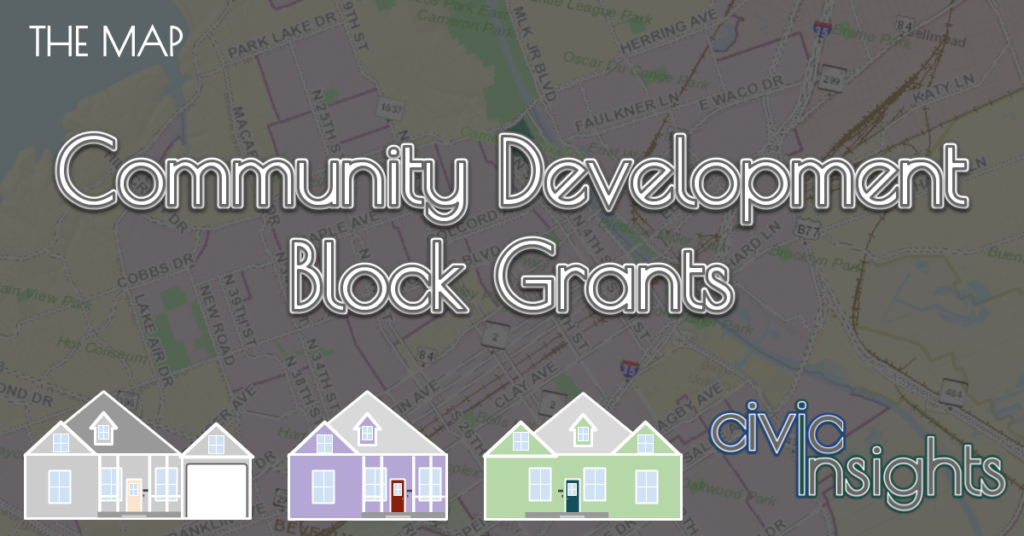Civic Insights: Understanding what areas of town are eligible for Community Development Block Grants (CDBG)

(City council, school board, planning commission, county commissioners – these groups and several others represent us. They do the day to day work of running our community. It is our responsibility to keep informed about their work so that we can help them represent us effectively. “Civic Insights” by Jeffrey Vitarius is a regular feature of Act Locally Waco. Its purpose is to help us understand decisions that shape our community so that we can participate effectively as informed, engaged residents of Waco. – ALW)
By Jeffrey Vitarius
Two weeks ago we tackled breaking down a sentence about the City Council’s Community Development Block Grant (CDBG) public hearing. During the course of the City Council’s review of that item, Council Member Sabio raised a question regarding this map of CDBG eligible areas:

It was noted at the meeting that the borders included above come from the federal government and are based on census information. I thought it might be interesting to find out the how and why behind this map. Let’s jump right in.
The CDBG program was created by the Housing and Community Development Act of 1974 (HCDA). Section 104(b)(3) of the act identifies the three “national objectives” of the program:
- Benefiting low- and moderate-income persons,
- Preventing or eliminating blight, or
- Meeting an urgent need (this one is a little complicated)
CDBG funding has to go towards achieving one of these objectives.
As noted in the Department of Housing and Urban Development (HUD)’s Guide to National Objectives and Eligible Activities for CDBG Entitlement Communities benefiting low- and moderate income persons “is usually spoken of as the most important national objective of the CDBG program because of the related requirement that the vast majority of CDBG expenditures must be for activities that meet this objective.” Translation, most programs are directed towards the benefiting low- and moderate-income persons objective. Also, as an FYI, entitlement communities are local governments that develop CDBG programs and receive funding to implement them (like the City of Waco).
The question then becomes how does an “entitlement community” establish that a particular program or project is benefiting low- and moderate-income persons. HUD has outlined four different ways to meet this goal. A program can simply serve a limited clientele. If a particular program only or mostly provides services to low- and moderate-income folks, then it can easily be said to be fulfilling the national objective.
But what if a program or project doesn’t serve specific people? What is the “clientele” of a park? This is where the “area benefit” criteria comes into play. For this method the “entitlement community” identifies the service area of a program or project. If most of the residents (defined as 51%) in that service area have a low- or moderate-income the project can be considered to fulfill the national objective.
This possibility opens up a host of other questions. What income level makes a resident a low- or moderate-income? How do you determine a service area? What data can be used to determine if an area has low- or moderate-income residents? We’ll tackle each of these questions in more detail below. But first let’s take one quick sidestep to the remaining two criteria. Housing development and job creation programs are unique enough to warrant their own criteria. We do not have the space this week to delve into those criteria, but it’s worthwhile to know they are out there.
Back to our questions.
What income level makes a resident a low- or moderate-income?
Section 102 of the HCDA defines low- or moderate-income as 80% of the median income in the area. So first you determine an area’s “median family income.” This is the income you would find at the exact middle of Waco’s income distribution (for the math folks, we are looking at median here rather than mean or average). If you put all the family incomes from Waco in order it would be the one at the middle of your list. HUD identifies this as $65,700 in Waco. 80% of that number is approximately $52,550. Once you scale this for family size (larger families have a higher income threshold), you can determine if any given resident is low- or moderate-income. More details on these thresholds can be found at this useful tool put together by HUD.
How do you determine a service area?
Service area is the kind of idea that makes a lot of sense in theory and is really hard to define in practice. If you think back to our park example, you can probably imagine what the area served by that park might be, but if you had to sit down and draw it out on a street grid, it would get difficult fast. How far away is walking distance? Do we consider residents who can drive? Do busy streets separate “service areas” from one another?
As a result of this complexity HUD has placed the responsibility of determining service areas on “entitlement communities.” The guide I noted above states that “HUD will generally accept a grantee’s determination unless the nature of the activity or its location raises serious doubts about the area
claimed by the grantee.” Basically, as long as the service area doesn’t “look fishy” HUD will likely accept it as reasonable.
The range of what is or isn’t reasonable is very broad here. Based on the information in the City’s consolidated and annual plans (see this previous post for more info on what those plans are) it looks like Waco focuses on “block groups.” These are the smallest geographic units used by the census. You can think of them as literal groups of city blocks. According to the census, block groups typically have between 3,000 and 6,000 residents. The map at the beginning of this post breaks down Waco into these “block groups.”
What data can be used to determine if an area has low- or moderate-income residents?
So thinking of a “typical” block group of 5,000 residents. We now know that it is considered a low- or-moderate income service area if 2,550 (51%) of those residents reside in families (the distinction between families and households is interesting, but complicated and out of our reach here) that make less than 80% of median income for Waco. So how do we actually know if that is the case?
There are two ways HUD has endorsed for a community to accomplish this. The first is to use HUD’s own data (the Low Moderate Income Survey Data [LMISD]). The second is to conduct their own survey of residents following certain HUD guidance and minimum standards. Waco uses HUD’s data. That data can be found using this GIS application provided by HUD. On that application you can draw out service areas or just take a look at block groups and see which ones clear the 51% threshold (HUD provides a useful video introduction to the application here).
If we look at Waco’s consolidated five-year plan we find a section focused on geographic distribution (AP-50). In that section the city notes:
The City allocates infrastructure and facility improvements (not related to special needs populations [remember our limited clientele option]) within the CDBG Target Areas — those census block groups with 51% or more low to moderate-income residents.
This brings us back to the map at the top. There we find all of the block groups in Waco where at least 51% of the residents make less than 80% of Waco’s median income. These areas are the focus of much of Waco’s CDBG funding. Over time, as income levels move and data changes, this map will change too.

Jeffrey Vitarius has been actively local since early 2017. He lives in Sanger Heights with partner (JD) and his son (Callahan). He helped found Waco Pride Network and now serves as that organization’s treasurer and Pride Planning Chair. Jeffrey works at City Center Waco where he helps keep Downtown Waco clean, safe, and vibrant. He is a member of St. Alban’s Episcopal Church and graduated from Baylor in 2011.
The Act Locally Waco blog publishes posts with a connection to these aspirations for Waco. If you are interested in writing for the Act Locally Waco Blog, please email [email protected]for more information.
